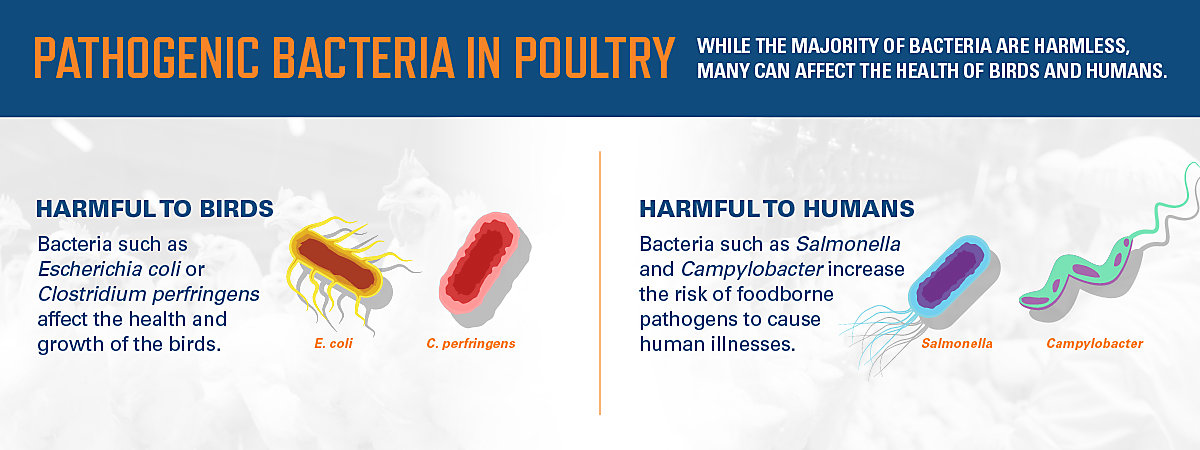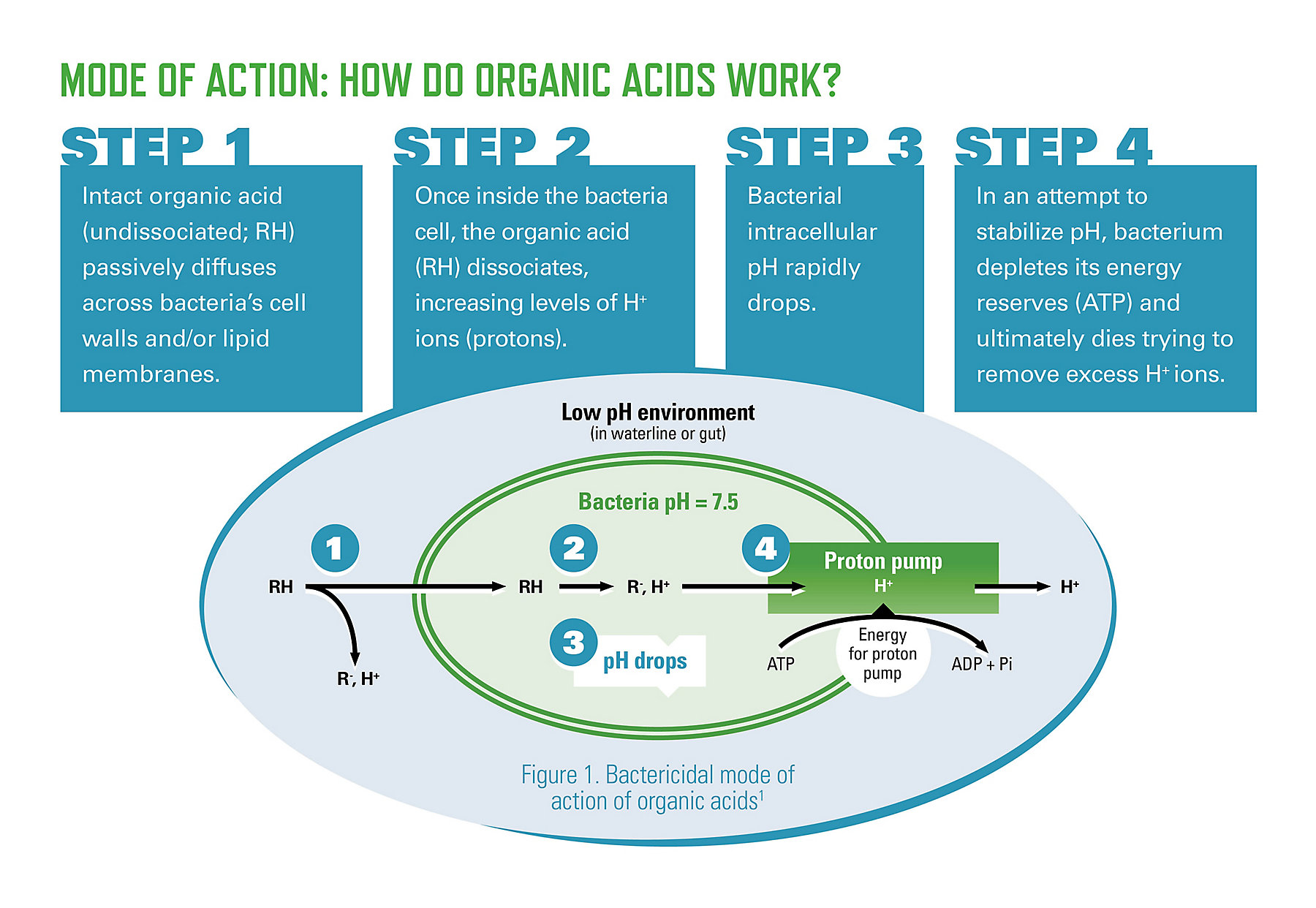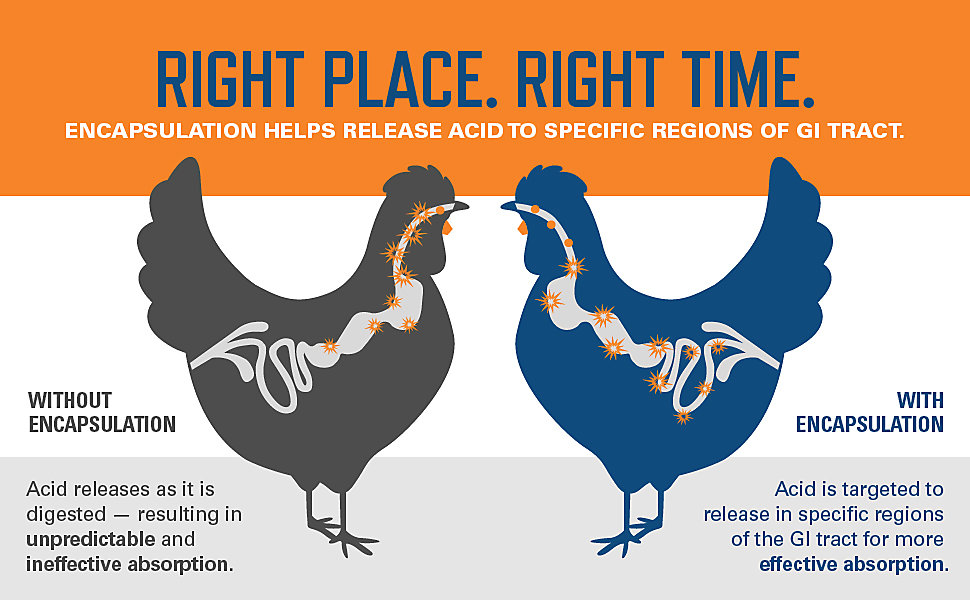
Organic Acid’s Dual Role: Improved Bird Health, Safer Processing
Bacteria are one of the major microbes present in poultry. While many bacteria are harmless, there are some pathogenic bacteria which can be detrimental to bird health and performance. Pathogenic bacteria present in poultry can be broadly classified into two categories:
- The first is bacteria which are harmful to the birds such as Escherichia coli or Clostridium perfringens which affect the health and growth of the birds. This type of bacterial infection can be primary – causing disease directly – like E. coli infections, or secondary – happening after another infection – for example, Clostridium infection after coccidiosis infestation.
- The second is bacteria like Salmonella and Campylobacter. They are usually harmless residents of the gastrointestinal (GI) tract of the birds, but when the bacterial load is high going into the processing plant, this increases the potential risk of human foodborne illness. Importantly, the probability of meat contamination during processing increases significantly if the bacterial load of the birds is high.1,2

For a producer, these two different bacteria categories should both be addressed to make sure that the birds are performing well during the growth period and food safety is also supported. While antibiotics are able to prevent some of these issues, the continued push within the industry to reduce antibiotic usage necessitates the implementation of alternate strategies. Gut acidifiers, if used in proper form, offer a safe way to address these issues effectively.
Gut Acidifiers
Gut acidifiers are organic or inorganic acids, and their salts, which lower the pH in the gastrointestinal tract. Formic, propionic, butyric, citric, sorbic, lactic and benzoic acids are some of the common organic acidifiers used in animal feed. While in the past, acidifiers were primarily used to decrease the bacterial load in the animal feed, recent evidence indicates they are able to act on bacteria in vivo as well.
The resulting decrease of pH after acidifier administration in the gastrointestinal tract helps birds in numerous ways. Inhibition of the growth of pathogenic microbes is, of course, the major benefit. Maintaining a low pH in the stomach of proper activation and functioning of digestive enzymes, complementing the stomach hydrochloric acid to enhance protein digestion and improving overall gut health are also benefits of acidifier administration.3,4
Mode of Action of Gut Acidifiers/Organic Acids
While organic acids offer multiple health benefits as discussed above, one of their primary functions is the impact on bacteria in the GI tract. Organic acids like formic acid and their salts have been shown to decrease the growth of harmful gram-negative bacteria such as Clostridium perfringens, Escherichia coli and Salmonella ssp. Further, there is evidence that they do not negatively impact, and possibly even enhance, the growth of beneficial gram-positive bacteria such as Lactobacilli ssp.12
When the organic acid (salt form) reaches the GI tract intact, the salt will dissolve when it comes into contact with water, forming the acid again because of its inherent chemical nature. For example, when sodium formate is supplemented, it dissolves and forms formic acid in the stomach. While there might be very subtle differences between supplementing the acid directly or supplementing the salt of the acid in terms of effectiveness and functionality, supplementing the salt form provides advantages in terms of handling during manufacturing and at the feed mill.

In the GI tract, when the acid comes into contact with the bacteria, it enters the bacteria through the cell membrane and dissolves inside the bacteria. When an acid dissolves in a liquid medium, it separates in a process called ionization. Because of the ionization process, the dissolved acid dissociates into two ions, an anion (RCOO-) and a proton (H+). For example, formic acid which has a molecular formula of HCOOH when dissolved in water becomes HCOO- and H+. The anion (HCOO-) accumulation itself has negative effects on the bacterial cell metabolism, but the majority of the detrimental effect to bacteria happens through proton accumulation. The proton, because of its chemical nature (more proton = more acidic or lower pH, pH is inversely proportional to proton concentration) starts decreasing the pH inside the bacteria as its concentration goes up.
The majority of harmful bacteria tend to keep their internal pH around 7 because all the vital molecular functions happen efficiently at that pH. Since the accumulating H+ is going to bring the pH down, the bacteria tries to pump the excess H+ ion outside the cell (efflux) using ATP, otherwise known as the cellular currency. If more acid is present in the environment, more acid enters the bacterial cell resulting in the H+ efflux machinery to be continuously active depleting the energy for vital functions eventually leading to the bacteria’s death.5,6,4
Delivering the Organic Acids to the Right Intestinal Region
Organic acids, or their salts when administered as such, won’t be able to reach the lower parts of the GI tract where most of the pathogenic microbes reside because they will be utilized in the upper GI tract. These pathogenic microbes in the hindgut act as a reservoir for not only diseases in birds and meat contamination during processing, but also, they persist in the environment even after thorough cleaning of the barn and act as seeders to colonize the next batch of birds. Keeping these pathogenic microbes at a lower load helps the subsequent flocks as well.
Microencapsulation helps release the acid in specific regions of the gastrointestinal tract – including the lower part of the GI tract – making them more effective and helping to control the inclusion level. If the organic acid is targeted towards both the pathogenic microbes of the birds and also to prevent foodborne pathogen contamination, as discussed above, the product should be able to work in both the upper and lower part of the GI tract.
Kemin has a proprietary encapsulation process which allows a molecule to be encapsulated in such a way that the product impacts specific regions of the GI tract. This encapsulation process addresses both categories of bacteria, poultry disease-causing bacteria and foodborne illness-causing bacteria.2,7

Uniqueness of Formic Acid
Each organic acid has unique properties and benefits based on its chemical structure. One of the major factors for the effectiveness of formic acid is its small molecular size and chain length (HCOoH), which allows it to enter the bacterial cell easily compared to other organic acids.
Formic acid is also unique in that it has one of the lowest pKa (acid dissociation constant, 3.75) of any organic acid. pKa is the pH at which half of the acid is dissociated. A lower pKa indicates that it’s a relatively strong acid and would be able to donate its H+ ion easily. In other words, once inside the bacterial cell, the H+ ion becomes free easily, which will bring the pH down quickly, and the bacteria needs to spend its energy at its own detriment to export it out and maintain the pH.8
FORMYL™ Na
FORMYL Na is an encapsulated form of formic acid salt manufactured using a proprietary process which delivers the active molecule throughout the gastrointestinal tract. Multiple research and field trials conducted indicate that FORMYL Na was able to reduce the issues associated with disease-causing microbes in live birds, improve performance and decrease the bacterial load as birds go to processing. FORMYL Na, by utilizing the unique nature of formic acid and proprietary encapsulation technology, provides value to producers by improving bird health and decreasing the thread of foodborne illnesses.9-11
To learn more, visit www.kemin.com/formylna.
References
1Thøfner, Ida and Christensen, Jens-Peter, 8 – Bacterial diseases in poultry, in Advancements and Technologies in Pig and Poultry Bacterial Disease Control, N. Foster, I. Kyriazakis, and P. Barrow, Editors. 2021, Academic Press. p. 199-227.
2Amalaradjou, Mary Anne Roshni and Bhunia, Arun K., Chapter Five – Modern Approaches in Probiotics Research to Control Foodborne Pathogens, in Advances in Food and Nutrition Research, H. Jeyakumar, Editor. 2012, Academic Press. p. 185-239.
3Ahmed, S. T., Hwang, J. A., Hoon, J., Mun, H. S., and Yang, C. J., (2014). Comparison of single and blend acidifiers as alternative to antibiotics on growth performance, fecal microflora, and humoral immunity in weaned piglets. Asian-Australas J Anim Sci. 27: 93-100.
4Pearlin, B. V., Muthuvel, S., Govidasamy, P., Villavan, M., Alagawany, M., Ragab Farag, M., Dhama, K., and Gopi, M., (2020). Role of acidifiers in livestock nutrition and health: A review. J Anim Physiol Anim Nutr (Berl).
5Vassilis Papatsiros. V. G., C. Billinis, The Prophylactic Use of Acidifiers as Antibacterial Agents in Swine, in Antimicrobial Agents, D.V. Bobbarala, Editor. 2012, InTech.
6Jacela, J. Y., DeRouchey, J. M., and Tokach, M. D., (2009). Feed additives for swine: Fact sheets – acidifiers and antibiotics. Journal of Swine Health and Production. 17: 270-275.
7Mannina, Paolo, Mani, Venkatesh, Rubach, Jon, Camellini, Claudia, Arduini, Lauro, and Lao, Ye, (2018). Development of a New FORMYL Product for the US Poultry and Swine Market. Kemin 18-00030.
8Ricke, Steven C., Dittoe, Dana K., and Richardson, Kurt E., (2020). Formic Acid as an Antimicrobial for Poultry Production: A Review. Frontiers in Veterinary Science. 7.
9Mani, Venkatesh, Rubach, Jon, Mannina, Paolo, and Poss, Mitch, (2017). Evaluation of a Micro Encapsulated Formyl Na Treatment on Mitigation of Necrotic Enteritis And Improving Growth Performance In Broilers. Kemin 17-00227.
10Van Meter, Patty, Mani, Venkatesh, Rubach, Jon, Mannina, Paolo, and Poss, Mitch, (2019). Formyl™ Na Process Validation Testing. Kemin 19-354.
11Iseri, Vanessa, (2020). Evaluate FORMYL™ Na on broiler performance and Salmonella and Campylobacter prevalence at the processing plant. Kemin 20-6430.
12Lückstädt C, editor. Acidifiers in animal nutrition. Nottingham University Press; 2008.







